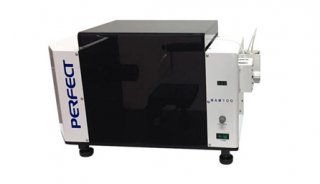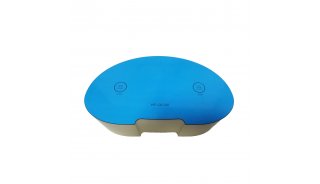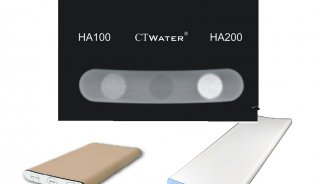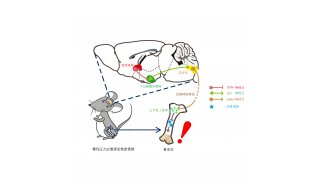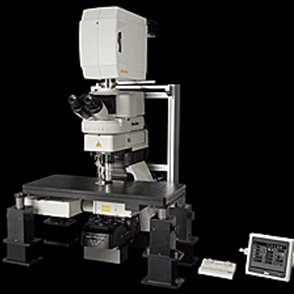小鼠不同周龄与骨密度的关系(一)
【摘要】目的 采用pQcT设备,以整体小鼠胫骨为检测对象,了解不同周龄骨密度含量以及不同组分面积,为进行小鼠骨代谢研究提供参考。方法 4~12周龄昆明种小鼠3O只,雌性,每6只为1组。用戊巴比妥钠麻醉后,固定于检测台上,以右后肢为被测对象,采用德国产动物用pQcT设备,分别对胫骨近端骨骺线1.4nnn和4.0inin处进行测定。结果 小鼠4~12周龄,体重增长很快,周龄与体重的相关性r=O.963,P<0.001;此阶段胫骨总骨密度、皮质骨密度随着周龄的增长而增加,呈非常显著的正相关;周龄与骨小梁的骨密度无明显相关性;8周龄时胫骨小梁面积最大。结论 pQcT能灵敏、精确的测定整体小鼠胫骨,有效地区分各个不同组分,可以动态的观察骨骼的变化,以8—1O周龄的小鼠适宜造模型。
【关键词】pQcT;骨密度;胫骨;小鼠
Age-related changes in bone mineral density and cross-sectional area in mice YNA Xueming.ZHANG Zhende.Shanghai Institute of Materia Medwa,Chinese Academy of Sciences,Shanghai 201203,China
【Abstract】Objective
Age-relatde changes in bone mineral density(BMD),cross—sectional area
of the tibia in vivo were measured by peripheral quantitative computed
tomography(pQcT),and the correlation was analyzed,providing the reference for the resarch on bone metabolismin mice.Methods
Thirty female mice were di vided into age groups of4,6,8,10 and 12
weeks,6 each.The mice werefixed withholder under anesthesia.BMD and
cross-sectional area were measured by pQcT(Stratec,XCT,Research SA)at 1.4 and 4.0 mm from the proximal epiphysis of tibia.Results
The body weight of female mice increased quickly during 4-12 weeks of
age,and showed age dependemcy with significant
correlation(r=0.963,P<O.001);the total and cortical BMD have in
creased at 4—12 weeks as well as corss-sectional area.and they
werecorrelated significandy.But trabecular BMD increased slowly without
correlation during the period,and the maximal trabccular area appeared
at 8 weeks of age. ConclusionThe pQcT
precisely defermines various regions of mouse tibia in
vivo.Therefore,measurement in vivo is useful for the momtofing of
skeletal changes in mice.Mice at the ages of 8-10 weeks are suitable for
develop ment of osteoporosis models.
【Key words】pQcT; Bone mineral density;Tibia; Mouse
骨质疏松症的研究在我国虽然起步较晚,但是选择合适的骨质疏松动物模型是进行骨质疏松药物筛选的基础,同时必须有灵敏、精确的检测手段,才能事半功倍。
pQcT(peripheral quantitative computed tomography)外周骨定量计算机断层扫描是非侵入性的检测方法,检测对象可从实验小动物到人类骨骼。可对骨样 品的皮质骨和松质骨分别进行测定,检测的准确度和精确度均高于DEXA[1,2]。在国外的临床和动物实验中被广泛地应用于骨质疏松的诊断和治疗效果的评价。国内对pQcT的使用及有关的报道很少,尤其未见到小鼠的检测数据。本研究采用pQcT设备,以4一l2周龄整体小鼠胫骨为检测对象进行比较,旨在为进行有关小鼠骨代谢的研究提供参考。
材料和方法
1.方法:30只昆明种小鼠。雌性。体重l6—40g,(上海实验动物中心提供),分别为4,6,8,10,12周龄,每组6只,经1d适应性饲养,用戊巴比妥钠麻醉,途径ip,剂量60mg·kg-1,动物麻醉后固定于特制的检测台上,以右后肢为被测对象。
2.仪器和检测:pQcT(peripheral quantitative computed tomography),XCTResearchSA(德国Stratec公司生产),检测时先纵向扫描,显示右后肢胫骨近端的形态,以骨骺线为参照线向下1.4mm和4.0mm处作断层测定。计算指标为骨密度(mg/cm3)和面积(mm2)。
3.统计学处理:每组结果以平均值±标准差( ![]() ±s)表示,用t检验进行两组间比较,应用MicrosoftExcel2000将获 得的数据进行双方差线性pearson相关分析。
±s)表示,用t检验进行两组间比较,应用MicrosoftExcel2000将获 得的数据进行双方差线性pearson相关分析。
结果
1.小鼠4~12周龄是体重增长较快的时期,随着周龄的增长体重明显增加r=0.963,P<0.001),见图1。







